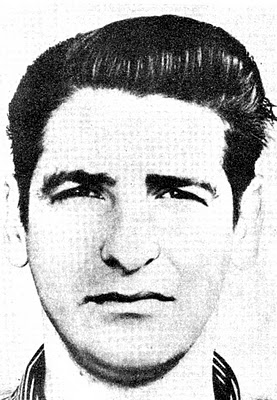Police Make Major Breakthrough in the Boston Strangler Case
After more than 50 years, “incredible advances” in DNA technology have tied the man who claimed to be the Boston Strangler to the last of the 13 murders that haunted the city in the 1960’s, ending lingering doubts for the woman’s family.
According to investigators, on January 4, 1964, 19-year-old Mary Sullivan was found raped and murdered in her Charles Street apartment. It was the last of a string of grisly, unsolved incidents that left city residents unsettled and on edge for more than 19 months. Despite a confession from a man named Albert DeSalvo, who took credit for the Boston Strangler murders, and the death of Sullivan, he was never charged because his admission was ruled out in court. DeSalvo, after confessing to the murders, was sentenced to life in prison on unrelated charges involving armed robberies and sexual assaults on other women, because officials couldn’t prove his guilt.
But Boston Police officials said Thursday that they now have enough evidence to formally posthumously convict DeSalvo for Sullivan’s murder. In a joint media briefing with Suffolk County District Attorney Daniel Conley, Massachusetts Attorney General Martha Coakley, and Boston Police Commissioner Ed Davis, investigators revealed that due to technological advances in how they solve murder cases, they were able to link DeSalvo to the woman’s death, despite previous doubts about his alleged connection. “For almost five decades, the only link between DeSalvo was his confession. That confession has been the subject of skepticism and controversy from almost the moment it was given…there was no forensic evidence to link DeSalvo to the murder. Until today,” said Conley. “Given the facts and circumstances of this case there can be no doubt that the DNA [found on the body of the victim] can be linked to the man who murdered Mary Sullivan.”
Conley said the evidence from Sullivan’s murder doesn’t apply to the other homicides contributed to the Strangler, even though DeSalvo confessed. He said there is a disagreement to this day between investigators about whether or not they were committed by the same person. “At this point in time, that is a question we cannot answer, but these developments give us a glimmer of hope there can one day be…accountability for the women murdered so cruelly between 1962 to 1963,” Conley said. “It remains controversial. We don’t claim DeSalvo is a suspect in each of them. By we do stand by the claim of unprecedented certainty in Sullivan’s murder.”
Officials will exhume the body of DeSalvo sometime this week and take it to the Chief Medical Examiner’s office to further the investigation.
In December of 2001, top investigators were adamant that DeSalvo, who died in prison in 1973, was in no way connected to the death of Sullivan, going as far as saying if they were sitting on a jury they would say he was “not guilty,” according to a New York Times report. That stance is a far cry from the developments released by city and state officials, who used DNA evidence found on a water bottle used by the suspect’s nephew in order to connect him to the crime.
Between June 14, 1962 and January 4, 1964, the city of Boston experienced a level of “panic, fright and fear never quite before seen, felt, or witnessed,” police said, as 13 single women between the ages of 19 and 85 were murdered by strangulation in and around the city. The Boston Strangler would convince females to let him in their house only to kill them after gaining entry.
The first death at the hands of the Boston Strangler took place in a Gainsboro Street apartment in 1962, where a 55-year-old woman was choked with a rope, according to reports. The killings continued until January of 1964, making the self-proclaimed murderer, DeSalvo, one of the nation’s first modern day serial killers at the time of the attacks.
Casey Sherman, the nephew of Sullivan, who has dedicated a lot of his life to investigating, and seeking the truth about his aunt’s death, said he wasn’t happy that information about updates into the murder were leaked ahead of the official press conference Thursday. “So the DA’s office and Boston Police have told me they have found significant evidence in my aunt Mary Sullivan’s murder and the Boston Strangler case. I was asked to stay quiet about this, but someone from law enforcement leaked it to the media and now my phone has exploded. Not very happy about that,” he said, prior to meeting with police to get the new information. A day before the announcement, Sherman, a Boston-based crime novelist, asked his Facebook followers for support, and “good mojo.”
At Thursday’s meeting, he thanked investigators for their efforts. “The last 24 hours has been quite trying for myself, and my mother, Diane,” Sherman said. “But I want to thank [police] and their incredible persistence. [For years] it has been myself and my mother raising questions about the Boston Strangler case…it provides an incredible amount of closure for me and my mother. We aren’t done yet…but we are getting there. I just want to say—I have lived with Mary’s memory everyday. My whole life. And I didn’t know other people were living with her memory as well and it;s amazing to me today that people really did care what happened to my aunt.”
Conley thanked Sherman for “keeping the investigation alive” over the last few decades by conducting his own crime work.
Investigators hope that the latest breakthrough in the case will lead to other biological evidence left behind in connection with the other murders.
The story has piqued the interest of people nation-wide, and has also been on the Hollywood radar. As of Thursday, there was no news on how this may impact a movie currently in production that is based on the Strangler’s murders in Boston. The movie, which will have the tone similar to other crime thrillers like Se7en and Zodiac, and will star Casey Affleck, was picked up by Warner Bros. entertainment in December of 2012, according to Deadline.com.



